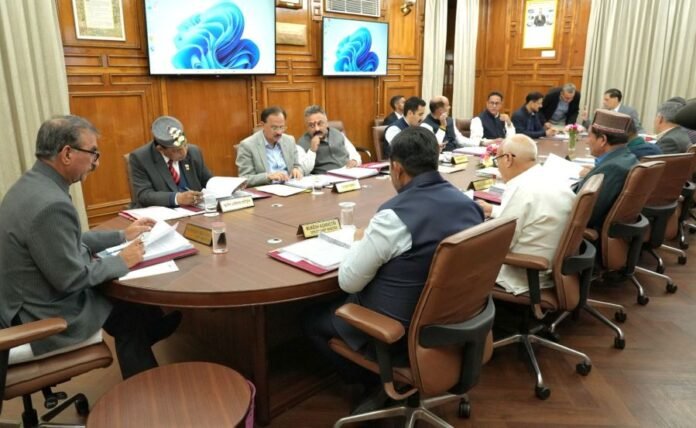In a sweeping series of policy decisions that reflect both local necessity and broader governance innovation, the Himachal Pradesh Cabinet, under Chief Minister Thakur Sukhvinder Singh Sukhu, has outlined a multi-pronged transformation agenda that touches nearly every facet of public life — from employment regularisation and digital court reforms to urban infrastructure and medical expansion. The meeting, held in the state capital Shimla, signalled a governance strategy that leans toward decentralisation, technological integration, and sustainable development, with potential national implications.
One of the most socially resonant decisions was the move to regularise part-time Class-IV workers employed in various state departments. Those who have served continuously for at least seven years by March 2025 will be transitioned into daily-wage employment. In a state where public employment remains a lifeline for thousands, this decision not only offers financial stability but also acknowledges the years of informal and often overlooked labour by low-income workers. It may set a precedent for other Indian states grappling with contractual employment systems and growing worker discontent.
On the judicial front, the Cabinet approved the Himachal Pradesh Online Filing and Processing of Court Cases Rules, 2025 — a forward-looking move that allows for digitisation of applications, appeals, and legal petitions in Revenue Courts. The transition to digital platforms, particularly in rural and hilly terrain, can drastically reduce logistical burdens for citizens who often travel long distances to access justice. While digital inclusion remains an ongoing challenge, this initiative positions Himachal as a regional leader in e-governance within India’s federal framework.
The state’s efforts to decentralise departmental operations were also evident in its decision to shift the Wildlife Wing of the Forest Department from Shimla to Dharamshala, in the Kangra district. Not only does this rebalancing of administrative geography bring decision-making closer to ecologically critical regions, it also reduces the administrative over-centralisation in the state capital — a long-standing governance issue in many hill states across the Global South.
In an important shift in criminal justice infrastructure, the District Jail in Mandi will be relocated to a newly constructed facility in Nerchowk, while the old premises will be repurposed as an open jail for women. This progressive model, focusing on rehabilitation over incarceration, aligns with global trends in criminal justice reform. Such facilities, which permit inmates to work and interact within a controlled environment, have shown promise in reducing recidivism and promoting reintegration.
Public transport — a challenge in the steep terrain of Himachal Pradesh — received a boost with the allocation of 350 new stage carriage routes across the state. Private operators will also be allowed to run 18-seater tempo travellers on additional routes based on local demand. This decision directly addresses connectivity gaps, particularly in remote rural areas where bus services are lifelines for economic mobility and access to education and healthcare.
The Cabinet also focused heavily on health infrastructure. It approved the recruitment of 81 medical officers, specifically strengthening emergency and trauma services in government-run hospitals and cancer care facilities. Additionally, 18 professionals will be hired to bolster the Department of Forensic Services, and 11 subject matter specialists will support agricultural extension services through Krishi Vigyan Kendras, institutions pivotal to India’s agrarian knowledge transfer.
ज़रूर, यहां हिमाचल प्रदेश कैबिनेट की बैठक में लिए गए मुख्य निर्णयों का सरल और पठनीय हिंदी में सारांश दिया गया है:
- नियमित रोजगार: जो पार्ट-टाइम चतुर्थ श्रेणी कर्मचारी 31 मार्च 2025 तक सात साल की लगातार सेवा पूरी कर चुके हैं, उन्हें दैनिक वेतनभोगी बनाया जाएगा।
- वन्यजीव विभाग का स्थानांतरण: वन विभाग के वन्यजीव विंग को शिमला से धर्मशाला (जिला कांगड़ा) स्थानांतरित किया जाएगा।
- जेल सुधार: मंडी की जिला जेल को नेरचौक में नई इमारत में स्थानांतरित किया जाएगा, और पुरानी जेल को महिलाओं के लिए ‘ओपन जेल’ बनाया जाएगा।
- डिजिटल कोर्ट सिस्टम: राजस्व विभाग के तहत ऑनलाइन कोर्ट केस फाइलिंग और प्रोसेसिंग के नए नियम लागू होंगे, जिससे केस ऑनलाइन दर्ज और निपटाए जा सकेंगे।
- नियुक्तियों का नया ढांचा: विभिन्न विभागों में भर्तियों की प्रक्रिया को सुधारने के लिए नई गाइडलाइंस बनाई गई हैं और इसके लिए एक कैबिनेट उप-समिति का गठन होगा।
- परिवहन में सुधार: राज्य में 350 नई बस रूट्स की मंजूरी दी गई है। इसके साथ ही निजी ऑपरेटरों को 18-सीटर टेम्पो ट्रैवलर चलाने की अनुमति दी गई है।
- स्वास्थ्य सेवाएं: 81 नए मेडिकल ऑफिसर (डॉक्टर) नियुक्त किए जाएंगे, जिनमें आपातकालीन सेवाओं और कैंसर केयर को प्राथमिकता दी जाएगी। फोरेंसिक विभाग में भी 18 नई भर्तियां होंगी।
- कृषि विस्तार: कृषि विज्ञान केंद्रों में 11 सब्जेक्ट मैटर स्पेशलिस्ट नियुक्त किए जाएंगे।
- शहरी ढांचा: शिमला के छोटा शिमला इलाके में 14 और 17 मंजिला दो आधुनिक कमर्शियल टॉवर बनाए जाएंगे, जिससे प्रशासन और व्यापारिक जरूरतें पूरी की जा सकें।
- जल आपूर्ति: जल शक्ति विभाग को पंचायती स्तर पर जल योजनाओं का कार्यान्वयन और रखरखाव करने का जिम्मा दिया गया है।
- स्वास्थ्य और शिक्षा के लिए ज़मीन आवंटन:
- एम्स बिलासपुर के विस्तार के लिए जमीन केंद्र सरकार को निशुल्क दी जाएगी।
- चंबा जिले में नवोदय विद्यालय खोलने के लिए भी ज़मीन आवंटित की गई है।
- शहरी निकाय पर निर्णय: शिमला जिले के सुन्नी नगर पंचायत को नगरपालिका में बदलने का पुराना निर्णय वापस ले लिया गया है।
ये फैसले हिमाचल प्रदेश को प्रशासनिक, सामाजिक और तकनीकी रूप से अधिक सक्षम और जनोन्मुखी बनाने की दिशा में एक मजबूत कदम हैं।
Perhaps the most visually transformative announcement was the approval of a new commercial complex in the heart of Shimla. The twin high-rise structures — standing 14 and 17 storeys tall — will address the capital’s expanding administrative and business needs. Shimla, a city originally built by the British as a seasonal retreat, has struggled with vertical expansion due to heritage regulations and fragile mountain terrain. This project, therefore, will be watched closely for how it balances modernity with environmental and cultural preservation.
On the education and healthcare fronts, the Cabinet approved major land transfers to central government ministries. Over 21 bighas of land will be transferred free of cost to expand the All India Institute of Medical Sciences (AIIMS) in Bilaspur. Additionally, more than 52 bighas have been earmarked for a Jawahar Navodaya Vidyalaya in Chamba district, strengthening rural access to quality education.
The decision to roll back the earlier upgradation of Nagar Panchayat Sunni to a Municipal Council might seem minor, but it speaks volumes about the state’s responsiveness to local dynamics. While such upgrades are often seen as markers of development, they also come with regulatory changes that can impact small communities. This reversal suggests a rare sensitivity to local sentiment, often lost in the broader politics of urban expansion.
Through these cumulative actions, the Himachal Pradesh government is crafting a governance narrative that’s not only rooted in local exigencies but also aligned with global developmental discourses. Whether it’s empowering women inmates through open jails, digitising rural courts, or enabling last-mile connectivity in hill villages, the Cabinet’s decisions reveal a state attempting to rise beyond its geographic constraints through thoughtful policy-making.
In a nation often bogged down by bureaucratic inertia and political one-upmanship, Himachal Pradesh’s model — humble but comprehensive — may well offer a replicable roadmap for governance that is inclusive, adaptive, and quietly revolutionary.
Disclaimer: This article is based on publicly available information and official government releases.
#InclusiveGovernance #SustainableDevelopment #DigitalJustice #PublicHealthAccess #HimalayanPolicyShift




